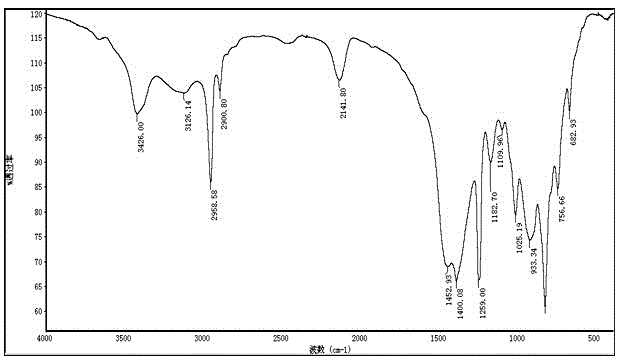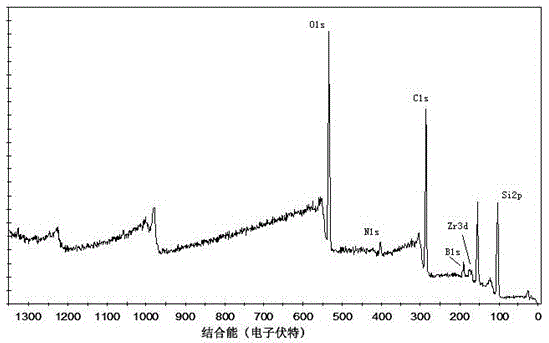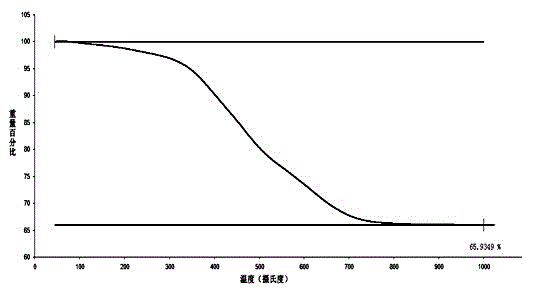Preparation method of poly-zirconium-boron-silazane precursor
A technology of silazane and precursor is applied in the field of preparation of polyzirconium borosilazane precursor, which can solve the problems such as no report on the preparation method of polyzirconium borosilazane precursor, and achieves low price, good processing performance, low cost effect
- Summary
- Abstract
- Description
- Claims
- Application Information
AI Technical Summary
Problems solved by technology
Method used
Image
Examples
Embodiment 1
[0028] This embodiment includes the following steps:
[0029] (1) Weigh 0.15 mol of zirconium tetrachloride, 0.15 mol of boron trichloride, 0.15 mol of trichlorosilane, and 0.9 mol of heptamethyldisilazane;
[0030] (2) Dissolving boron trichloride and trichlorosilane in n-hexane;
[0031] (3) Add the weighed zirconium tetrachloride into a 250ml three-necked flask equipped with a stirrer, a constant pressure funnel, and a distillation device, vacuumize and fill with dry nitrogen for three times, and cool the reactor to minus 15°C;
[0032] (4) Inject the n-hexane solution of boron trichloride and the n-hexane solution of trichlorosilane into a three-necked flask protected by dry nitrogen, then inject heptamethyldisilazane into the constant pressure funnel, and stir while Heptamethyldisilazane was added dropwise in the three-necked flask;
[0033] (5) After the dropwise addition, the reactor was heated to 270°C at a rate of 0.5°C / min, and kept at this temperature for 10 hours...
Embodiment 2
[0040] This embodiment includes the following steps:
[0041] (1) Weigh 1.5 mol of zirconocene dichloride, 0.3 mol of methyl boron dichloride, 0.15 mol of silicon tetrachloride, and 4.5 mol of N-ethylhexamethyldisilazane;
[0042] (2) Dissolving methyl boron dichloride and silicon tetrachloride in cyclopentane;
[0043] (3) Add the weighed zirconocene dichloride into a 500ml three-neck flask equipped with a stirrer, constant pressure funnel, and distillation device, vacuumize and fill with dry nitrogen four times, and cool the reactor to minus 10°C ;
[0044] (4) Inject cyclopentane dissolved in methyl boron dichloride and cyclopentane dissolved in silicon tetrachloride into a three-necked flask protected by dry nitrogen, and then N-ethylhexamethyldisilazane Inject into the constant pressure funnel, and while stirring, add N-ethylhexamethyldisilazane into the three-necked flask in a dropwise manner;
[0045] (5) After the dropwise addition, the reactor was heated to 300°C a...
Embodiment 3
[0049] This embodiment includes the following steps:
[0050] (1) Weigh 0.015 mol of zirconocene dichloride, 0.15 mol of phenyldichloroborane, 0.15 mol of butyltrichlorosilane, and 0.1 mol of N-methylhexaethyldisilazane;
[0051] (2) Dissolving phenyldichloroborane and butyltrichlorosilane in toluene;
[0052] (3) Add the weighed zirconocene dichloride into a 250ml three-neck flask equipped with a stirrer, constant pressure funnel, and distillation device, vacuumize and fill with dry nitrogen four times, and cool the reactor to minus 10°C ;
[0053] (4) Inject the toluene dissolved in phenyldichloroborane and the toluene dissolved in butyltrichlorosilane into a three-necked flask protected by dry nitrogen, and then pour the obtained N-methylhexaethyldisilazane Inject it into a constant pressure funnel, and while stirring, add N-methylhexaethyldisilazane into the three-necked flask in a dropwise manner;
[0054] (5) After the dropwise addition, the reactor was heated to 320°...
PUM
 Login to View More
Login to View More Abstract
Description
Claims
Application Information
 Login to View More
Login to View More - R&D
- Intellectual Property
- Life Sciences
- Materials
- Tech Scout
- Unparalleled Data Quality
- Higher Quality Content
- 60% Fewer Hallucinations
Browse by: Latest US Patents, China's latest patents, Technical Efficacy Thesaurus, Application Domain, Technology Topic, Popular Technical Reports.
© 2025 PatSnap. All rights reserved.Legal|Privacy policy|Modern Slavery Act Transparency Statement|Sitemap|About US| Contact US: help@patsnap.com



